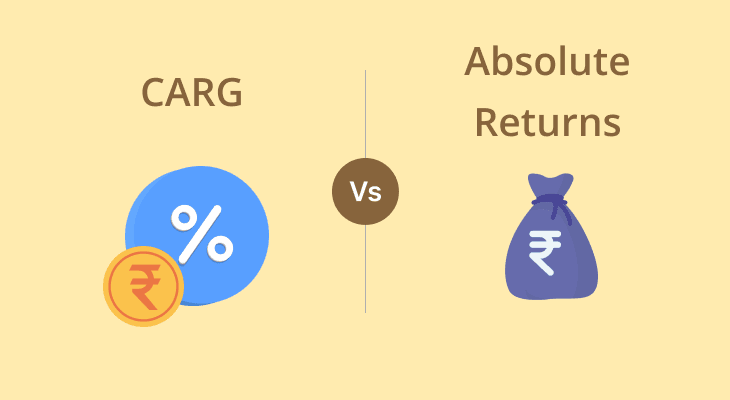
Table of content
CAGR vs Absolute Returns: Which is Better for Mutual Funds?
Evaluating mutual fund returns is crucial for investors aiming to achieve their financial goals. Two commonly used metrics in this evaluation are the Compound Annual Growth Rate (CAGR) and Absolute Returns. Understanding these metrics, their calculations, and their appropriate applications can provide deeper insights into investment performance and aid in making informed decisions.
CAGR Explained: How Compound Annual Growth Rate Works and Its Significance
The mean annual growth rate of an investment over a specified period is represented through the Compound Annual Growth Rate (CAGR), with the assumption that profits are reinvested at the end of each period. CAGR provides a smoothed annual rate of return, eliminating the effects of volatility and offering a clearer picture of an investment's performance over time.
The formula for calculating CAGR is:
CAGR = [(Ending Value / Beginning Value)1/n] − 1
Where:
- Ending Value = Value of the investment at the end of the period
- Beginning Value = Value of the investment at the start of the period
- n = Number of years
For example, suppose you invested ₹ 100,000 in a mutual fund, and its value grew to ₹ 175,000 over five years. The CAGR would be calculated as:
CAGR = [(175,000 / 100,000)1/5] − 1
(1.75)0.2 − 1 = ~ 0.1184 or 11.84%
This indicates that the investment grew at an average annual rate of 11.84% over the five-year period.
Significance of CAGR:
- Time Consideration: CAGR accounts for the investment duration, providing a standardised annual growth rate.
- Performance Comparison: It enables investors to compare the performance of different investments over varying time frames on an equal footing.
- Volatility Smoothing: By averaging returns, CAGR mitigates the impact of short-term market fluctuations, offering a clearer long-term perspective.
Limitations of CAGR:
- Ignores Interim Volatility: CAGR does not reflect the investment's volatility or interim fluctuations during the period.
- Assumes Constant Growth: It presumes a steady growth rate, which may not align with actual market conditions.
- Not Ideal for Short-Term Investments: For periods less than a year, CAGR may not provide meaningful insights.
Absolute Returns Explained: What Absolute Return Tells You About Your Investment
Absolute Return measures the total percentage increase or decrease in the value of an investment over a specific period, without considering the time factor. It reflects the overall gain or loss from the initial investment amount
The formula to calculate Absolute Returns is:
Absolute Return = [(Current Value − Initial Investment) / Initial Investment)] × 100
For example, if you invested ₹ 50,000 in a mutual fund, and its value increased to ₹ 70,000 after 3 years:
Absolute Return = [(70,000 − 50,000 / 50,000)] × 100
(20,000 / 50,000) × 100 = 40%
This indicates a 40% total return on your investment over the 3-year period.
Significance of Absolute Returns:
- Simplicity: Provides a straightforward measure of the total gain or loss on an investment.
- Short-Term Assessment: Useful for evaluating investments held for less than a year, where annualized metrics like CAGR may not be as relevant.
- Project Evaluation: Helps in assessing the profitability of time-bound projects or investments.
Limitations of Absolute Returns:
- Ignores Time Factor: Absolute returns do not account for the duration of the investment, making it less useful for comparing investments held over different time periods.
- Lacks Annualised Perspective: Without considering time, it doesn't provide insight into the investment's annual performance.
- Not Ideal for Long-Term Comparisons: Absolute returns can be misleading for long-term investments as they don't reflect the compound growth effect over time.
Which is Better? When to Use Each Measure for Evaluation
Both CAGR and Absolute Returns serve specific purposes in investment evaluation, and the right metric depends on the investor's objectives, investment duration, and need for comparability. Understanding the distinctions between CAGR and Absolute Returns is vital for accurate investment evaluation.
Aspect | CAGR | Absolute Returns |
Time Consideration | Accounts for the investment period, providing an annual growth rate. | Ignores the time period, focusing solely on total gain or loss. |
Use Case | Ideal for long-term investments to assess consistent growth. | Suitable for short-term investments or specific project evaluations. |
Volatility Reflection | Smooths out short-term fluctuations, not showing interim volatility. | Reflects total change but does not indicate variability during the period. |
Complexity | Requires more complex calculations, considering compounding. | Simple calculation, offering a quick snapshot of performance. |
When to Use Absolute Return
Absolute Return is most useful when you want to determine the total percentage change in an investment’s value over a given period. It is particularly relevant in the following scenarios:
- Short-Term Investments: If you invest in a mutual fund for a few months or less than a year, Absolute Return gives you a direct measure of how much your money has grown or declined.
- One-Time Investments: If you want to evaluate a lump-sum investment and are not concerned about the time taken to achieve the returns, Absolute Return provides a clear picture.
- Measuring Fixed-Term Returns: Investors who allocate funds for a specific short-term financial goal, such as saving for a vacation or an upcoming expense, can use Absolute Return to assess the investment outcome.
For example, your ₹ 100,000 mutual fund investment grows to ₹ 110,000 in 6 months.
Absolute Return: [(110,000 − 100,000) / 100,000] × 100 = 10%
Since the investment was held for only six months, Absolute Return effectively shows the overall gain. However, this metric does not indicate whether the returns were achieved in a steady manner or if there was significant volatility.
When to Use CAGR
CAGR is a more appropriate measure when assessing the long-term performance of an investment and comparing different investment options. Use CAGR in the following scenarios:
- Long-Term Investment Performance: If you have held a mutual fund for several years, CAGR provides a standardized annual growth rate, which is more informative than Absolute Return.
- Comparing Investment Options: Since different investments may have different durations, using Absolute Returns can be misleading. CAGR standardizes the growth rate, allowing for fair comparisons.
- Understanding the Effect of Compounding: CAGR accounts for the reinvestment of returns, making it useful for assessing investments that benefit from compounding over time.
Consider another scenario where your ₹ 1,00,000 investment grows to ₹ 1,50,000 in 3 years. Here, CAGR offers insight into the annual growth rate, which is more informative for long-term investments
- Absolute Return: [(150,000 − 100,000 / 100,000)] × 100 = 50%
- CAGR: [(150,000 / 100,000)1/3 − 1 = ~ 14.47%
Things To Keep In Mind
- Align with Financial Goals: Determine whether your investment objectives are short-term or long-term and choose the metric that aligns with your goals.
- Consider Investment Horizon: Use Absolute Return for short-term assessments and CAGR for long-term evaluations.
- Evaluate Risk Tolerance: Understand that CAGR smooths out volatility, which may mask potential risks associated with an investment.
Conclusion
So, which option for calculating mutual fund returns is better? The answer is – neither metric is inherently "better" than the other as each serves a different purpose. For short-term investments or one-time evaluations, Absolute Return may be sufficient. For long-term investments, especially those that benefit from compounding, CAGR provides a more accurate assessment.
To make informed investment decisions, you should use both CAGR and Absolute Return in conjunction — Absolute Return to measure overall gains and CAGR to assess long-term performance and compare different investment options. By understanding when to use each measure, you can better evaluate mutual fund returns and align your investment choices with your financial goals.
SIPs let you invest small amounts regularly, making it easier to stay consistent with your goals. With time, your money grows faster through compounding, helping you get the most out of your investments. Try our SIP Calculator to see how your money can grow and make smarter plans for your future
FAQ
What is Absolute Return in mutual funds?
Absolute Return measures the total percentage change in the value of an investment over a specific period, without considering the time factor. It indicates how much an investment has gained or lost in absolute terms.
What is CAGR, and how does it differ from Absolute Return?
The mean annual growth rate of an investment over a specified period is represented through the Compound Annual Growth Rate (CAGR), with the assumption that profits are reinvested at the end of each period. Unlike Absolute Return, CAGR accounts for the time value, providing a smoothed annual rate of return.
How is Absolute Return calculated?
Absolute Return is calculated using the formula:
Absolute Return (%) = (Final Value − Initial Value) / Initial Value × 100
How is CAGR calculated?
CAGR is calculated using the formula:
CAGR (%) = ((Final Value / Initial Value)1/n −1) × 100
When should I use Absolute Return over CAGR?
Absolute Return is most appropriate for short-term investments, typically less than a year, where the focus is on the total gain or loss without considering the investment duration.
Why is CAGR preferred for long-term investments?
CAGR provides a normalized annual growth rate, accounting for the effects of compounding over time. This makes it ideal for evaluating and comparing the performance of long-term investments.
Can Absolute Return and CAGR yield different insights for the same investment?
Yes, Absolute Return shows the total growth, while CAGR illustrates the annual growth rate. An investment might have a high Absolute Return over a long period, but the CAGR could reveal a modest annual growth rate.
Are there limitations to using Absolute Return?
Absolute Return doesn't consider the time period of the investment, making it less useful for comparing investments of different durations.
What are the limitations of using CAGR?
CAGR assumes a constant growth rate and doesn't reflect investment volatility. It may oversimplify performance by smoothing out fluctuations.
How can I decide which metric to use for evaluating mutual fund performance?
Use Absolute Return for short-term assessments to understand total gains or losses. For long-term investments, CAGR offers a better perspective on annualized growth, aiding in comparisons between different investment options.


